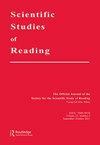有阅读障碍的成年人如何识别口语单词?来自行为和脑电图数据的证据
IF 2.4
2区 教育学
Q1 EDUCATION & EDUCATIONAL RESEARCH
引用次数: 0
摘要
【摘要】目的研究成人阅读障碍(DYS)中语音缺陷对口语加工的持续影响,主要包括知觉任务和复杂认知操作。对口语识别本身的关注要少得多。我们的研究旨在填补这一空白。方法有阅读障碍和无阅读障碍的成年人(两组:N = 30,平均年龄= 21岁,50%为女性,100%为欧洲白人)进行听觉词汇决策任务。记录工作表现和ERP。结果两组反应时间均表现出词汇性效应,但ERP对刺激词汇性的反应不同。熟练阅读者在N400后期(414-581msec)对假词表现出典型的振幅增强,而DYS在N400早期(246-413msec)表现出相反的模式。两组在词汇后后期(582-800msec)假词加工过程中均表现出较强的消极性。结论ERP数据显示,尽管两种人群的行为结果具有可比性,但在单词识别的词汇阶段存在细微差异。我们假设,对完整语义知识的更强依赖可能有助于DYS在词汇加工的不同阶段对单词的普遍增强和持续的ERP反应,尽管需要证实。关键词:成人阅读障碍;口语单词识别;听觉词汇决策;词汇性效应;补充材料本文的补充数据可在https://doi.org/10.1080/10888438.2023.2218503.Notes1上在线获取。同样的参与者样本被纳入(Denis-Noël et al., Citation2020).2。Alouette测试是一个265个单词的文本,由没有意义但语法和句法正确的句子组成。最终得分是考虑准确性和阅读时间的效率得分(Cavalli et al., Citation2018)。唯一性点是指一个单词中最早的音素位置,在这个位置上,这个单词可以与语言中的所有其他单词区分开来。偏离点是指最早没有真实单词与语音输入相容的音素位置。这两个值是基于lexque.org数据库计算的(New et al., Citation2001)。我们选择了具有此截止频率(0.4 Hz)的高通滤波器,因为我们的数据由于出汗而受到大量缓慢漂移的影响;我们的脑电图记录很大一部分是在夏季进行的。虽然较低的截止频率是可取的,但减少慢漂移是必要的,以避免拒绝大量参与者,也因为我们希望进行独立分量分析(ICA)来纠正眼伪影,并且发现低频漂移会对ICA的性能产生不利影响(Winkler等人,Citation2015) 5。微状态分析背后的思想是,正在进行的脑电图是由有限数量的原型脑电图地形组成的,这些地形在80毫秒到120毫秒之间保持稳定(Lehmann等人,Citation1987),这些离散的、准稳定的空间结构被称为微状态。本研究得到了法国研究部的支持:ANR- 13-JSH2-0002 (to C.P.)、ANR-16- conv2 -0002 (ILCB)、ANR-11- labx -0036 (BLRI)和艾克斯-马赛大学卓越计划(A*MIDEX)。本文章由计算机程序翻译,如有差异,请以英文原文为准。
How Do Adults with Dyslexia Recognize Spoken Words? Evidence from Behavioral and EEG Data
ABSTRACTPurpose In adults with dyslexia (DYS), the persistent influence of phonological deficits on spoken language processing has mainly been examined in either perceptual tasks or those tapping complex cognitive operations. Much less attention is devoted to spoken word recognition per se. Our study aimed to fill this gap.Method Adults with and without dyslexia (for both groups: N = 30, mean age = 21 years, 50% female, 100% white European) performed an auditory lexical decision task. Performance and ERP were recorded.Results Reaction times showed a lexicality effect in both groups although they differed in ERP responses to stimulus lexicality. Skilled readers showed the typical amplitude enhancement for pseudowords compared to words in a late phase of N400 (414-581msec) whereas DYS showed the opposite pattern in an earlier phase of N400 (246-413msec). Both groups showed a stronger negativity during pseudowords processing in the late post-lexical stage (582-800msec).Conclusions ERP data showed subtle differences between the two populations during the lexical stage of word recognition despite their comparable behavioral outcomes. We hypothesized that a stronger reliance on intact semantic knowledge might contribute to the general enhanced and sustained ERP responses to words in DYS across different phases of lexical processing, although confirmation is needed.Keywords: Adults with dyslexiaspoken word recognitionauditory lexical decisionEEGlexicality effectN400 Disclosure statementNo potential conflict of interest was reported by the authors.Supplementary materialSupplemental data for this article can be accessed online at https://doi.org/10.1080/10888438.2023.2218503.Notes1. The same sample of participants was included in (Denis-Noël et al., Citation2020).2. The Alouette test is a 265-words text composed of meaningless but grammatically and syntactically correct sentences. The final score is an efficiency score considering both accuracy and reading time (Cavalli et al., Citation2018).3. The uniqueness point refers to the earliest phoneme position in a word at which the word can be distinguished from all other words in the language. The deviation point refers to the earliest phoneme position from which no real word is compatible with the phonological input. These two values were computed based on the lexique.org database (New et al., Citation2001).4. We opted for a high-pass filter with this cutoff frequency (0.4 Hz) as our data suffered from a substantial amount of slow drift due to perspiration; a large proportion of our EEG recording was carried out during the summer months. While a lower cutoff frequency is preferable, reducing the slow drift was necessary to avoid rejecting a large number of participants and also because we wished to carry out Independent Components Analysis (ICA) to correct ocular artifacts and low-frequency drift has been found to adversely affect the performance of ICA (Winkler et al., Citation2015).5. The idea behind microstate analysis is that the ongoing EEG is composed of a limited number of prototypical EEG topographies that remain stable for a duration between 80 ms and 120 ms (Lehmann et al., Citation1987) and these discrete, quasi-stable spatial configurations are known as microstates.6. The temporal electrodes are not included in the analyses since they are not part of the regions that show strong neural responses in Figure 1Additional informationFundingThis work was supported by the French Ministry of Research: ANR- 13-JSH2-0002 (to C.P.), ANR-16-CONV-0002 (ILCB), ANR-11-LABX-0036 (BLRI) and the Excellence Initiative of Aix-Marseille University (A*MIDEX).
求助全文
通过发布文献求助,成功后即可免费获取论文全文。
去求助
来源期刊

Scientific Studies of Reading
Multiple-
CiteScore
7.20
自引率
2.70%
发文量
26
期刊介绍:
This journal publishes original empirical investigations dealing with all aspects of reading and its related areas, and, occasionally, scholarly reviews of the literature, papers focused on theory development, and discussions of social policy issues. Papers range from very basic studies to those whose main thrust is toward educational practice. The journal also includes work on "all aspects of reading and its related areas," a phrase that is sufficiently general to encompass issues related to word recognition, comprehension, writing, intervention, and assessment involving very young children and/or adults.
 求助内容:
求助内容: 应助结果提醒方式:
应助结果提醒方式:


